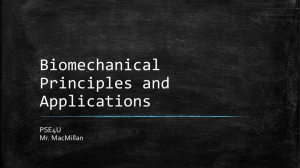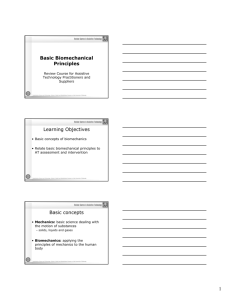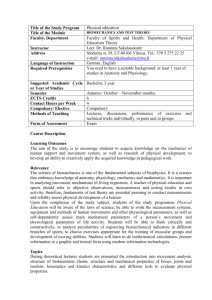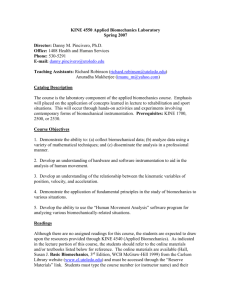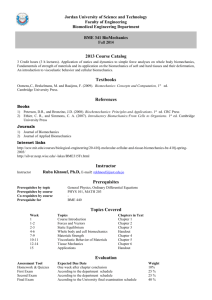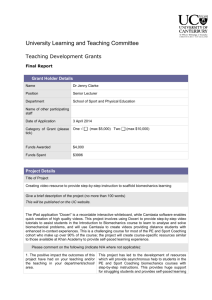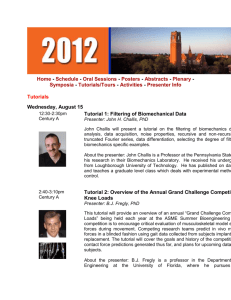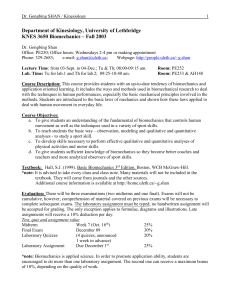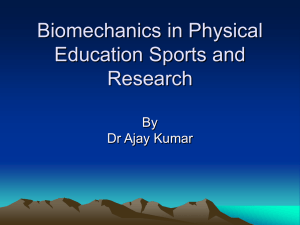Course description
advertisement
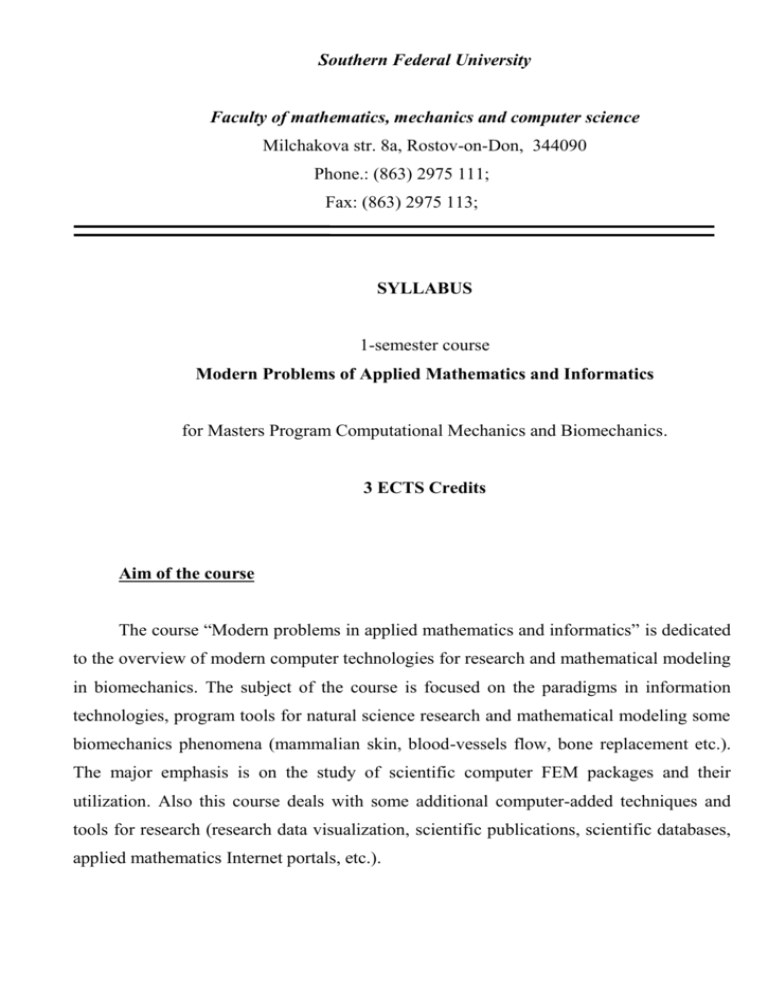
Southern Federal University Faculty of mathematics, mechanics and computer science Milchakova str. 8a, Rostov-on-Don, 344090 Phone.: (863) 2975 111; Fax: (863) 2975 113; SYLLABUS 1-semester course Modern Problems of Applied Mathematics and Informatics for Masters Program Computational Mechanics and Biomechanics. 3 ECTS Credits Aim of the course The course “Modern problems in applied mathematics and informatics” is dedicated to the overview of modern computer technologies for research and mathematical modeling in biomechanics. The subject of the course is focused on the paradigms in information technologies, program tools for natural science research and mathematical modeling some biomechanics phenomena (mammalian skin, blood-vessels flow, bone replacement etc.). The major emphasis is on the study of scientific computer FEM packages and their utilization. Also this course deals with some additional computer-added techniques and tools for research (research data visualization, scientific publications, scientific databases, applied mathematics Internet portals, etc.). 2 Techniques, Skills, etc. After completing the course, the students are expected to be able to: compare different parallel and distributed computational systems; choose and implement a suitable program tools for parallel coding; compare different database and knowledge base systems; compare different CAD/CAE systems; utilize additional program tools for research (visualization systems, computer packages for typesetting, etc.); ascertain basic approaches for mathematical modeling in biomechanics; understand and analyze the influence of approximation, calculations and modeling errors; utilize math packages (MATLAB, ANSYS etc.) for numerical experiments; present coherent arguments to answer questions both orally and in writing. Teaching The following methods and forms of study are used in the course: Lectures Problem sets Program packages utilization and coding Self-study Use of different reference books and Internet resources At the end of the course the students are supposed to do case-study, make an oral presentation and participate in discussion. Upon the successful completion, the students will gain 3 credits. Course content 3 # Subject № 1. 1 Introduction. Form of Duration Lesson (hrs) Lecture 1 Lecture 1 Lecture 2 Cloud computing as Lecture 2 Course organization, its aims and structure. Information on core and additional readings. 2. Role of information technologies and 2 computing tolls in applied math, i.e. natural science and engineering. 3. Parallel and Distributed computing 3 systems, their classification. Program tools for parallel coding. Grid systems and grid technologies 4. distributed scalable virtual 4 services. Self service on demand and resource pooling. Private, public, hybrid and community clouds. 5. Database and Knowledge base systems, 5 their classification: cloud database, data warehouse, Lecture 2 Date 4 distributed database, document-oriented database, graph database, hypermedia databases, parallel database, real-time database, spatial database. Data models: hierarchical, network, relational, object and object relational. Neural network. 6. CAD/CAE systems. Lecture 2 Their classifications and 6 potential. Comparison of CAD/CAE systems. 7. Scientific Lecture 2 Lecture 1 Colloquium 2 Self-study 16 computations and 7 computer algebra systems. Algebraic algorithms and symbolic computations 8. Additional program tools for research: visualization systems and image file formats, 8 computer packages for typesetting, scientific databases and Internet portals 9. 9 10. Essay presentation 1Mathematical model Lecture 4 5 10 for skin as soft tissue 11. 11 Two-phase Lecture 4 1Mathematical model Lecture 4 mathematical model for blood-vessel flow 12. 12 for quasi-one-dimensional hemodynamics 13. Mathematical Lecture 4 Colloquium 2 Self-study 16 Lecture 4 Laboratory 3 Lecture 3 modeling of the hip 13 replacement 14. Essay presentation 14 15. Finite element method and, its 15 foundations and technique 16. Computer modeling in mechanical and 16 biomechanical problems with Maple and Maxima 17. Computer modeling in mechanical and 17 biomechanical problems with Matlab 18. Computer modeling 3 in mechanical and 18 biomechanical problems with FlexPDE 19. 19 1Computer modeling in mechanical and biomechanical problems Lecture 3 6 with ANSYS 20. Computer modeling Lecture 3 Colloquium 2 Self-study 22 in mechanical and biomechanical problems 20 with Comsol 21. 21 Summarizing case- study presentation Requirements During the session students are required to attend class lectures; write essays; provide case-study; represent the essays and case-study results in oral presentation at the colloquium; be prepared to participate in final course discussion. Grade determination Class participation - 40% Written essay and its presentation – 15% (per each) Case-study and its presentation – 20% Participation in discussion – 10% 7 Literature Core 1. Encyclopedia of Computational Mechanics, Edited by Erwin Stein, Ren´e de Borst and Thomas J.R. Hughes. Volume 1: Fundamentals. Volume 2: Solids and Structures. Volume 3: Fluids. 2004. John Wiley & Sons. 2. Biomechanics: principles and applications / edited by D. Schneck and J. D. Bronzino. – CRC Press, 2003. – 300 p. 3. Computer Methods in Biomechanics and Biomedical Engineering, J. Middleton, University of Wales, Cardiff, Wales; Gyan Pande, University of Wales Swansea, Swansea, Wales, UK; M. L. Jones. 4. Mathematical Problem Solving and New Information Technologies Research in Contexts of Practice, Ponte, J.P.; Matos, J.F.; Matos, J.M.; Fernandes, D., 1992, XV, 346 p. 5. Fundamentals of Mobile and Pervasive Computing, by Frank Adelstein, Sandeep KS Gupta, Golden Richard III, and Loren Schwiebert, 2004 6. Distributed Systems: Principles and Paradigms, by Andrew S. Tanenbaum and Maarten Van Steen, 2006 7. An introduction to numerical methods: A MATLAB approach / Abdelwahab Kharab, Ronald B. Guenther.- 2nd ed.- Boka Raton, FL : Chapman & Hall/CRC, 2006. 8. Neural networks: methodology and applications G. Dreyfus - 2005 // Springer 9. Jiawei Han, Micheline Kamber & Jian Pei. Data Mining: Concepts and Techniques (The Morgan Kaufmann Series in Data Management Systems), 2006, 800 p. Additional 10. Biomechanics: Mechanical Properties of Living Tissues Fung, Y. C., 1993, 11. Fundamentals of Biomechanics: Equilibrium, Motion, and Deformation, 592 p. Leger, Dawn L. Nordin, Margareta, 1999, XXII, 393 p. 12. An Introduction to Biomechanics: Solids and Fluids, Analysis and Design Humphrey, Jay D., DeLange, Sherry 2004, XVII, 631 p. 8 13. Solving PDEs in C++ (Computational Science and Engineering), Yair Shapira Yair Shapira 14. Mobile Computing Principles: Designing and Developing Mobile Applications with UML and XML, by Reza B'Far and Roy T. Fielding, 2004 15. Cloud Computing: Implementation, Management, and Security, by John Rittinghouse and James Ransome,2009 16. Jamie MacLennan, ZhaoHui Tang, Bogdan Crivat . Data Mining with Microsoft SQL Server. Wiley, 2008.- 672 p. 17. Alan Dennis. Systems Analysis and Design with UML. Publisher: Wiley, 2007. 600 p. Internet Resources The World of Mathematical Equations. http://eqworld.ipmnet.ru/index.htm MavicaNET - Multilingual Search Catalog. http://www.mavicanet.ru/directory/ Biomechanics and Movement Science Listserver. http://biomch-l.isbweb.org Biomechanics Links. http://bones.ame.nd.edu/links.html MathWorld. http://mathworld.wolfram.com
